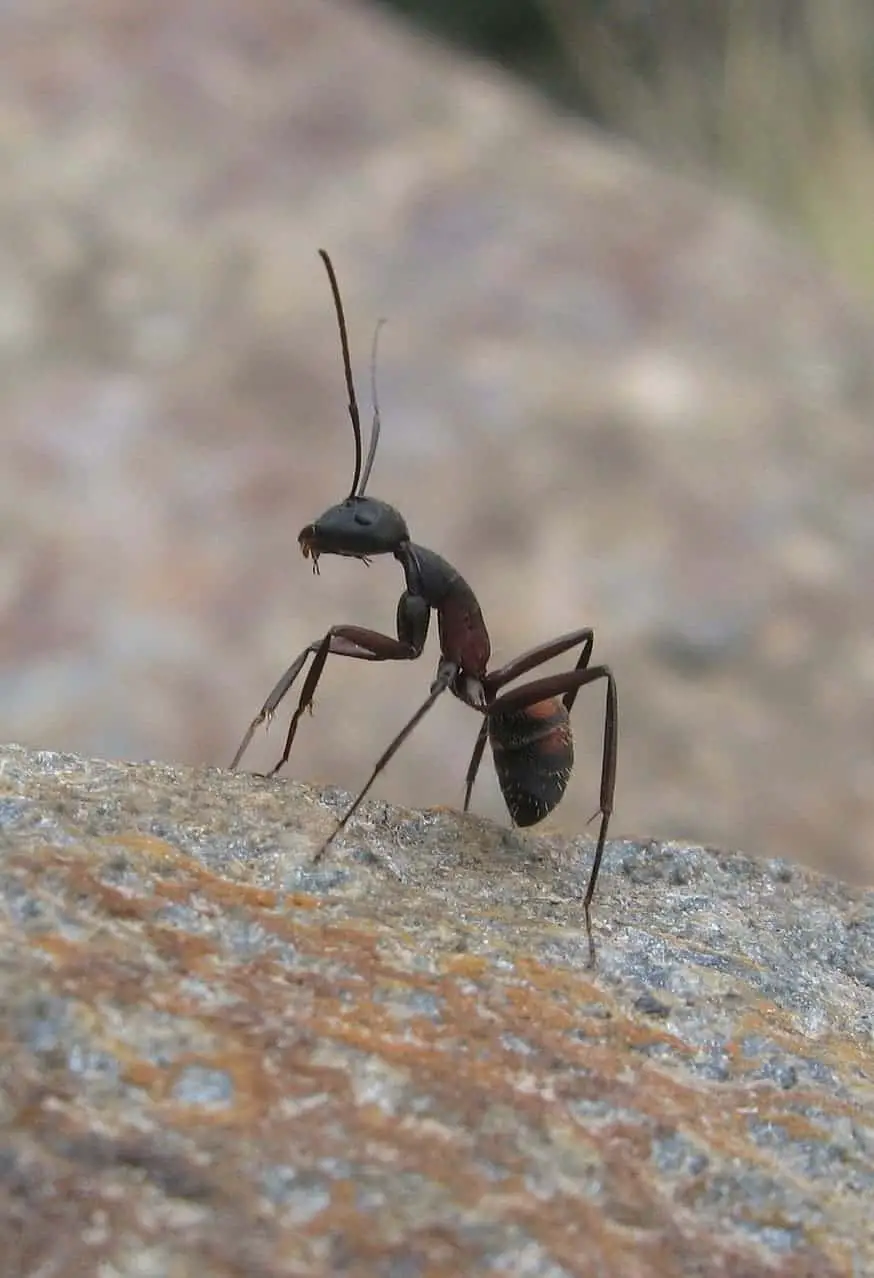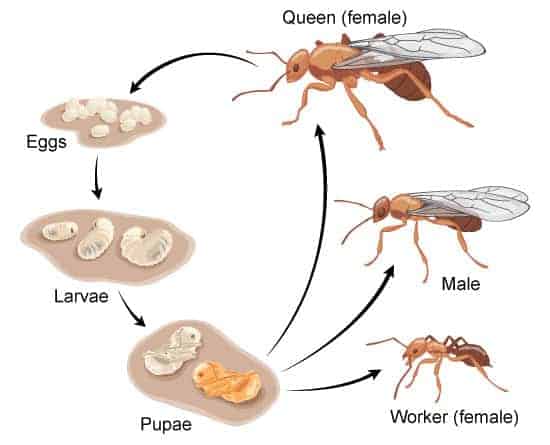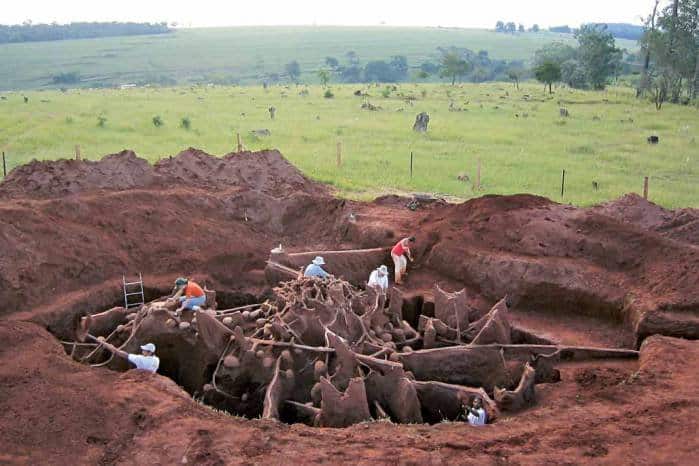This page gives you information about the biology of ants. What for species are ants, how do they live and what is their natural habitat. Despite being small creatures, you do not want to underestimate ants. They have an incredible social structure living in colonies. The most common pet ant species are the black garden ant (Lasius niger), the harvester ant (Messor barbarus), the red ant (Myrmica rubra) and the leaf-cutter ant (Atta sexdens). You can find more in-depth information about the species on this page.

Anatomy and morphology of ants
Ants belong to the phylum Anthropods, which means they have an exoskeleton. The exoskeleton is a fundamental part of the anatomy of ants. We have our skeleton as the backbone on the inside of our body. Ants have a skeleton on the outside, protecting the vital organs and muscles inside. Even though they have their skeleton on the outside, they can manoeuvre pretty quick still.
Their body exists of three main parts: the head, thorax and abdomen. Ants are distinctive in that they have a special segment between the thorax and abdomen: the so-called petiole. This very tiny segment makes it possible for ants to bent their abdomen beneath their body to spray poison to the enemy from their abdominal glands as a defence mechanism.

To their central thorax ants have six legs and on their head two antennae and compound eyes. They have two big jaws called mandibles and aren’t afraid to use them when they are attacked. Some ants have wings (these are the queen and kings, as we will discuss in the section about castes).
Ants come in many different colours, with many having black, brown, yellow and red coloured body parts. There are around 12.500 different ants species described, but the total is estimated at around 22.000 species. They can be found all over the world and are a very successful species in survival.
Social structure
All ant species live in colonies. There exist no ant species that live a solitary life. Ants have strictly divided tasks, and every ant is born to that task until it dies. Colonies can be as big as several million individuals and as small as a dozen or so, depending on the ant species. The social structure is quite impressive. We will talk about eusocialism and the caste system in the sections below. But we start with the life cycle of ants.

The life cycle of ant colonies
What does the lifecycle of an ant colony look like? A queen will found a colony. She is the only reproductive individual of the colony. After she established a good location for her colony, she will start laying eggs.
The ant life starts out as an egg. Ant eggs are tiny in size and often white oval-shaped. Some eggs are destined to become eaten by nestmates for extra nutrition, but most eggs will hatch into larvae.
Ant larvae are worm-shaped and do not have eyes or legs. Larvae are cared for by workers of the colony, or in the founding stage of a colony by the queen. They need a constant supply of food to grow, where they moult several times between sizes.
Ants have a complete metamorphosis – larvae will metamorphose in ant pupae to an adult. Pupae are already shaped more like ants. You can distinguish a head, abdomen and legs. Pupae are white-coloured at the beginning, but slowly turn darker to the colour the ants have (mostly brownish).
From the pupae emerge adult ants. When adults are newly hatched, they are light in colour, but will eventually become darker when they get older. Adults are mostly born as a female worker, but at some stages of the colony, they are born as new queens or males (king). Find more about the caste system of ants below.

Eusocialism
The eusocial system is described as the highest social system in nature. It is defined by three characteristics: cooperative brood care, overlapping generations of adults within the colony, and a division of labour into reproductive and non-reproductive groups.
Such division creates specialized groups within the colony where the “workers and soldiers” work together to create a living situation favourable for the brood, without producing their own offspring. Only the queen lays all the eggs. This social system is not much seen in species. One of the most known species that have adopted this social system is bees. However, you can find this social system with wasps, termites and naked mole rats too.
From an evolutionary point of view, such a social structure does not seem stable at all. Within the evolution theory, genes pass through based on the survival and fitness of the parents. Why does this social system work then? The workers, which are all female, include the same gene subset as the queen. So workers that care for the brood in a colony also take care of the genes they possess themself, and their sisters.
Colonies have more benefits. It is more powerful to take care of offspring with many than if you need to do it alone. And it is the same as a herd of zebras; you can count on each other.
It is a very complex system and goes beyond this article to explain in detail on here. If you want to know more about this social structure I can recommend you to read this article.
Territories
Another advantage of social life is the ability to make ground and draw up your territories. Ants can control huge areas where they gather the materials they need to survive. They are only focused on their own colony, that they are killing other insects, other ants and even their own ant species from other colonies if it is a treat to their colony.
Territories of ant are continuously at war with each other to control more ground. More ground means more food supplies. For this reason, you can never merge two existing colonies together. They are going to fight until one colony is left over.
Some colonies unite over a large area and form a supercolony. Within a supercolony, aggression is avoided, and ant nest are connected by underground passages or road work above ground. There are at least five supercolonies recognized in the world: Japan, Southern Europe, Australia, America and Switzerland.
Caste system
We shortly noted that within the eusocial system, every ant is born with a specific task. I already used the terms “workers” and “soldiers”. Ants are usually divided into three types called castes: Reproductive females (queens), reproductive males (kings) and non-reproductive females (workers).
Queens and males are the only ones with wings. They are used to find a mate during the nuptial flights. The time and weather need to be optimal for ants to start the flight.
The workers, which are smaller than the queen, may come in different sizes though they are the same species with the same gene pool. Mostly we talk about minors, majors and soldiers. Each of these subcastes has there own task within the colony. Soldiers, for example, will defend the colony and are used for their strong mandibles.
The caste system of the leaf-cutter ant (e.g. atta spp.) is very complex and contains seven different types of workers, and with each type of worker has its own specific role in maintaining the nest.

Natural habitat and behaviour
Ants can be found almost everywhere. On every continent (except Antarctica) there are ant species. A few exceptions are some island: Greenland, Iceland, the Hawaiian Islands, and some islands of Polynesia lack native ant species.
Ants have almost occupied every ecological niche and are fascinating in the way they exploit food resources. They live up in the trees, graze on large grasslands, there are even colonies that live in acorns. Ants seem to be very resourceful in ways to survive.
Despite the royal title and size of the queen ant, she does not control the colony. Ants live a very democratic way where workers decide which task to perform on preference (and the division of individuals specialized in different jobs), interactions with colony mates, and cues from the environment.
We said already that ants are very resourceful and opportunistic. This opportunistic lifestyle is illustrated, for example, that some ants species make ant bridges. Ants try to reach each other from both sides, and when ‘connected’ other ants can use this ant bridge to pass a gap.
Another example of the resourcefulness of ants can be seen in the way some ants form symbiotic relationships with other organisms. For example, some ants herding aphids because of the secretion of honeydew, which in turn is collected by ants. It goes even further, where ants protect them and move them to new areas where there are more resources for the aphids to produce honeydew. Ants are the only insects known to flock other species.
The way they communicate is mainly done by chemicals called pheromones. But ants also communicate with touch and sound. Many ant species make pheromone trails that can be followed by other ants. When an ant discovers a useful resource, it makes a trail from that back to the nest. Other ants can use that trail to find that resource as well. When a trail is blocked, ants will explore again to find a new way. If an ant is successful, it will mark the shortest route back reconnecting the trail again. Chemical signals within ants are highly developed.
If you like to know more about ants and the opportunistic way they live, you’ll definitely have to watch this documentary.
Ant nests and ant hills
Ants make many different nests. Examples of this are weaver ants, which live high in the trees and weave nest in trees, wood ants, which build large anthills and leaf-cutter ants that have huge structures beneath the ground. However, there are also nomadic species that don’t build nest or only build temporary nests.
Ant nests can be found in the ground, inside logs, under plants, stones or log, inside hollow stems, or even in acorns. Most ants use soil and plant materials to make the construction for their nests. However, weaver ants, for example, build nest by folding leaves and attach them with silk produced by their larvae.
Ants are outstanding builders, and ants do not just build a safe haven for the queen and the whole colony, but also build it in such a way to create their own optimal climate. They create ventilation holes and a thick layer of insulation. Leaf-cutter ants build one of the most impressive nest.

Food habits
Depending on the species of ants, they have feeding strategy as being generalists, scavengers, hunters, omnivorous, herbivorous, or being farmers. The diversity of ants is enormous, and so are their food habits.
To understand feeding behaviour, you’ll need to study that specific species. However, the basics of ants are that they need sugars for energy and proteins for their own development and the development of the colony (producing eggs, feeding larvae).
Most ants are foragers. They will leave the safety of the nest and go out to find and collect food. The most common food sources for ants to eat are plants, fruits, grains, seeds, nectar, and other insects. Many ants also use the opportunity to eat the honeydew secretion of aphids.
Many species use the opportunity to scavenge already dead insects and take them to their nest to eat. Some species are active predators and will kill and eat other small animals (mostly insects).
Some ant species are true specialists. We used the leaf-cutter ant multiple times already on this page, but that is a true specialist. This ant determines which leaves are most suitable to grow their own fungus that they eat.
Further reading
If you want to find out more about how to care for an ant colony, you should definitely check out the page about ‘caring for an ant colony‘.
Similar bugs to ants
Ants are fascinating bugs. If you like ants, you’ll probably also interested in the bugs below. You’ll find more bug species on the page ‘Choose your bug species‘.
Share this page!
